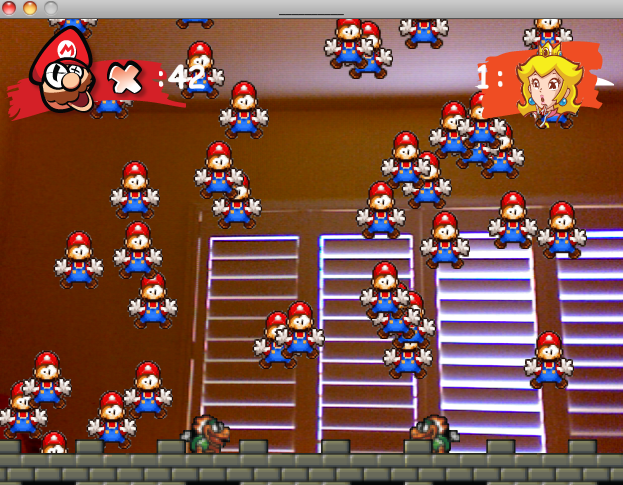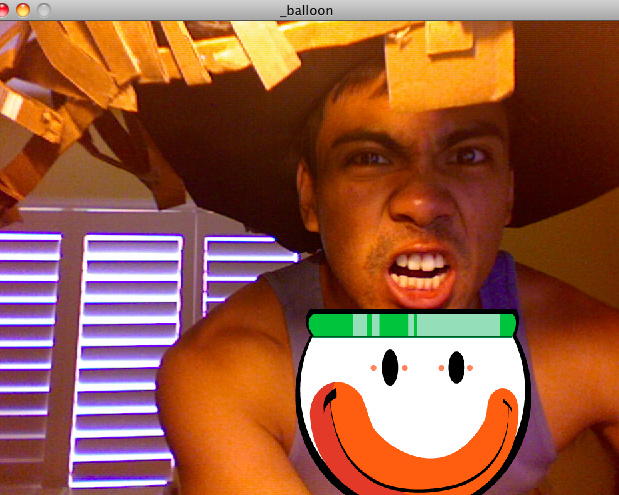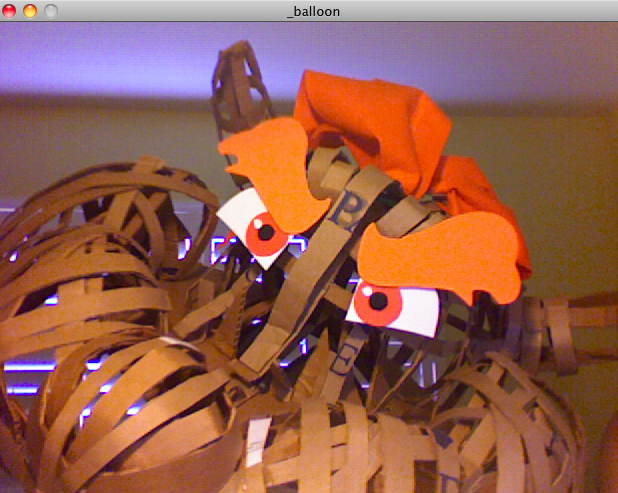Aquarium
Title
Super Mario Slaughter
Description
- Motivation
This piece was motivated by my interest in video games and idea that art doesn't need to be serious all the time (because you know, "art" is serious business). This piece is essentially a role reversal of the classic mario video game franchise. Here, the user assumes the role of bowser and indulges in a nonstop slaughter of his mortal enemy.
- Paradigm thing or whatever
Instead of using a traditional video game controller, the user swings his/her arms to kill the torrential downpour of marios. 100 mario kills equal 1 peach kill. I wanted to make something with a more intuitive interface (reflective of dreams?) ionno. hah.
- Technical Description
This piece utilizes OpenCV and processing to create a non-controller based user interface to immerse the user in a video game dreamscape (in respect to bowser).
Visualization
screenshot
intended balloon that was supposed to appear under the users face
bowser hat mock (for a more immersive experience)
Game code
import hypermedia.video.*; // Imports the OpenCV library
OpenCV opencv; // Creates a new OpenCV object PImage movementImg; // Creates a new PImage to hold the movement image int poppedBubbles; // Creates a variable to hold the total number of popped bubbles ArrayList bubbles; // Creates an ArrayList to hold the Bubble objects PImage mariodead; // Creates a PImage that will hold the image of the bubble PImage mario; PImage balloon; PImage peachcount; PImage castle; PFont font; // Creates a new font object int p; PImage dude1; PImage dude2; int c1 = 0; int c2 = 600; int h1 = 395; int h2 = 395;
import ddf.minim.*; //sound stuff
AudioPlayer player; Minim minim; AudioSample pain; AudioSample peach;
//------------------------------------------------------------------------------------------------------------------------------ void setup() {
size ( 635, 480,P2D ); // Window size of 640 x 480 minim = new Minim(this); // sound stuff opencv = new OpenCV( this ); // Initialises the OpenCV library opencv.capture( width, height ); // Sets the capture size to 640 x 480 movementImg = new PImage( 635, 480 ); // Initialises the PImage that holds the movement image poppedBubbles = 0;
p = 0;
bubbles = new ArrayList(); // Initialises the ArrayList
mario= loadImage("mario counter.png");
castle= loadImage("castle.png");
peachcount= loadImage("peachcount.png");
dude1 = loadImage("dude1.png");
dude2 = loadImage("dude2.png");
balloon=loadImage("balloon.png");
mariodead = loadImage("mariodead.png"); // Load the bubble image into memory
font = loadFont("ComicSansMS-Bold-48.vlw"); // Load the font file into memory
textFont(font, 32);
opencv.cascade( OpenCV.CASCADE_FRONTALFACE_ALT );
player = minim.loadFile("Bowsers_Castle.mp3", 2048); player.play();
pain = minim.loadSample("mario_pain.mp3", 2048);
peach = minim.loadSample("peach.mp3", 2048);
} //------------------------------------------------------------------------------------------------------------------------------ void draw() {
bubbles.add(new Bubble( (int)random( 0, width - 40), -mariodead.height, mariodead.width, mariodead.height)); // Adds a new bubble to the array with a random x position
opencv.read(); // Captures a frame from the camera
opencv.flip(OpenCV.FLIP_HORIZONTAL); // Flips the image horizontally
image( opencv.image(), 0, 0 ); // Draws the camera image to the screen
opencv.absDiff(); // Creates a difference image
opencv.convert(OpenCV.GRAY); // Converts to greyscale
opencv.blur(OpenCV.BLUR, 3); // Blur to remove camera noise
opencv.threshold(20); // Thresholds to convert to black and white
movementImg = opencv.image(); // Puts the OpenCV buffer into an image object
Rectangle[] faces = opencv.detect( 1.2, 2, OpenCV.HAAR_DO_CANNY_PRUNING, 100, 100 ); // balloon stuff
noFill();
noStroke();
for( int i=0; i<faces.length; i++ ) {
rect( faces[i].x, faces[i].y, faces[i].width, faces[i].height );
image (balloon, faces[i].x, faces[i].y+(faces[i].height), faces[i].width, faces[i].height);
}
for ( int i = 0; i < bubbles.size(); i++ ){ // For every bubble in the bubbles array
Bubble _bubble = (Bubble) bubbles.get(i); // Copies the current bubble into a temporary object
if(_bubble.update() == 1){ // If the bubble's update function returns '1'
bubbles.remove(i); // then remove the bubble from the array
_bubble = null; // and make the temporary bubble object null
i--; // since we've removed a bubble from the array, we need to subtract 1 from i, or we'll skip the next bubble
pain.trigger();
}else{ // If the bubble's update function doesn't return '1'
bubbles.set(i, _bubble); // Copys the updated temporary bubble object back into the array
_bubble = null; // Makes the temporary bubble object null.
}
}
opencv.remember(OpenCV.SOURCE, OpenCV.FLIP_HORIZONTAL); // Remembers the camera image so we can generate a difference image next frame. Since we've
// flipped the image earlier, we need to flip it here too.
image(mario, 10, 5);
text(":" + poppedBubbles, 160, 70); // Displays some text showing how many bubbles have been popped
image(peachcount, 480, 20);
text(p + ":", 480, 70);
if (c1 < 630) {
c1++;
}
else {
c1 = 0;
h1 = 395;
}
if (c2 > 0) {
c2--;
}
else {
c2 = 660;
h2 = 395;
}
//drawing the clouds on the screen with moving variables image(dude2, c1, h1); image(dude1, c2, h2); image(castle, 0, 420);
} //------------------------------------------------------------------------------------------------------------------------------ class Bubble {
int bubbleX, bubbleY, bubbleWidth, bubbleHeight; // Some variables to hold information about the bubble
Bubble ( int bX, int bY, int bW, int bH ) // The class constructor- sets the values when a new bubble object is made
{
bubbleX = bX;
bubbleY = bY;
bubbleWidth = bW;
bubbleHeight = bH;
}
int update() // The Bubble update function
{
int movementAmount; // Create and set a variable to hold the amount of white pixels detected in the area where the bubble is
movementAmount = 0;
for( int y = bubbleY; y < (bubbleY + (bubbleHeight-1)); y++ ){ // For loop that cycles through all of the pixels in the area the bubble occupies
for( int x = bubbleX; x < (bubbleX + (bubbleWidth-1)); x++ ){
if ( x < width && x > 0 && y < height && y > 0 ){ // If the current pixel is within the screen bondaries
if (brightness(movementImg.pixels[x + (y * width)]) > 127) // and if the brightness is above 127 (in this case, if it is white)
{
movementAmount++; // Add 1 to the movementAmount variable.
}
}
}
}
if (movementAmount > 5) // If more than 5 pixels of movement are detected in the bubble area
{
poppedBubbles++; // Add 1 to the variable that holds the number of popped bubbles
if (poppedBubbles > 100)
{
poppedBubbles = 0;
peach.trigger();
p++;
}
return 1; // Return 1 so that the bubble object is destroyed
}else{ // If less than 5 pixels of movement are detected,
bubbleY += 10; // increase the y position of the bubble so that it falls down
if (bubbleY > height) // If the bubble has dropped off of the bottom of the screen
{ return 1; } // Return '1' so that the bubble object is destroyed
image(mariodead, bubbleX, bubbleY); // Draws the bubble to the screen
return 0; // Returns '0' so that the bubble isn't destroyed
}
}
}
void stop() {
// always close Minim audio classes when you are done with them player.close(); opencv.stop(); minim.stop(); super.stop();
}
balloon code
import hypermedia.video.*;
OpenCV opencv;
PImage balloon;
void setup() {
size( 640, 480 );
balloon=loadImage("balloon.png");
opencv = new OpenCV( this );
opencv.capture( width, height ); // open video stream
opencv.cascade( OpenCV.CASCADE_FRONTALFACE_ALT ); // load detection description, here-> front face detection : "haarcascade_frontalface_alt.xml"
}
void draw() {
opencv.read();
Rectangle[] faces = opencv.detect( 1.2, 2, OpenCV.HAAR_DO_CANNY_PRUNING, 40, 40 );
image( opencv.image(), 0, 0 );
// draw face area(s)
noFill();
noStroke();
for( int i=0; i<faces.length; i++ ) {
rect( faces[i].x, faces[i].y, faces[i].width, faces[i].height );
image (balloon, faces[i].x, faces[i].y+(faces[i].height), faces[i].width, faces[i].height);
}
}


